Features
You are here
Antonio Gramsci, revolutionary

June 8, 2015
Antonio Gramsci is one of the few Marxist historical figures who have consistently retained popularity in the halls of universities and academic journals over the last three decades. His influence is regularly cited in political, cultural, anthropological studies as an important theoretical authority. Activists on the left also credit Gramsci with having formulated innovative and useful theoretical concepts about struggle and capitalism.
Unfortunately, with the explosion of Gramsci studies in the 1980s and 90s, his thought has more often than not been used to advance a reformist strategy to the problems of modern society. Only in the last decade have writers in the Marxist tradition been able to reestablish Gramsci at the heart of the revolutionary tradition and show him to be an implacable foe of bourgeois rule.
War and revolution
In the years before World War I, Gramsci was a student at the University of Turin. Financial problems and poor health eventually pulled him out of the University, but not before he acquired an extensive knowledge of history and philosophy.
The explosion of World War brought great misery and hardship to Italian workers. The war also brought, with it, a rapid expansion of trade and commerce. This, in turn, vastly increased the size of the industrial working class in major industrial centres like Turin, Milan and Genoa. As the war dragged on, acquiescence turned to anger as food shortages, requisitions and conscription saw workers and peasants clash with police. In Italy the war killed 615,000 people, left half a million disabled and another million wounded.
The 1917 Russian Revolution had an electrifying impact on workers and peasants in Italy. News of the overthrow of the Tsar, soldiers deserting and the formation of democratic councils of workers, peasants and soldiers (soviets) put new wind in the sails of workers suffering the exhaustion of war and repression. Strikes and occupations by rural workers led to the establishment of the eight-hour day in Italy. Workers were on the move.
The Biennio Rosso
In Italy, 1919 and 1920 became known as the “biennio rosso,” or “the two red years.” These years saw a sharpening of social unrest. In 1919 alone, there were 1,663 industrial strikes, up from 810 in 1913. In 1920, there were 1,881 industrial strikes. That year there were also upwards of two million peasants involved in strike action. Workers in the tens of thousands occupied their factories and formed factory councils, organizations of working-class “self -rule,” very similar in nature to the soviets in Russia. The movement reached its climax in August 1920 when metal workers in Milan joined with industrial workers in Turin in sparking a nation-wide occupation of factories.
Gramsci, a member of the Italian Socialist Party (PSI), helped found L’Ordine Nuovo, an unconventional worker’s journal. In these pages, Gramsci carried the argument that these factory councils were institutions that potentially represented the future workers’ state: “To link these institutions, coordinating and ordering them into a highly centralized hierarchy of competences and powers, while respecting the necessary autonomy and articulation of each, is to create a genuine workers’ democracy here and now.”
While the PSI grew rapidly during this period, it was split between its reformist and abstentionist wings, ensuring it took a complacent attitude towards the factory occupations. According to Angelo Tasca, the party had a “parasitic psychology, like that of a future heir sitting at the bedside of a dying man (the bourgeoisie) and thinking that to try and shorten his agony just isn’t worth the trouble.”
With the fascists waiting in the wings, Gramsci was prophetic in his assessment of the situation: “The present phase of the class struggle in Italy is the phase that precedes either the conquest of political power on the part of the revolutionary proletariat and the transition to new modes of production and distribution …or a tremendous reaction on the part of the propertied classes and governing caste.”
Gramsci argued for an alliance of the workers in the North and the peasantry in the South. He continued that, “it was essential that the party immerse itself in the reality of the class struggle…to be in a position to give real leadership to the movement as a whole.” Unfortunately, the PSI remained split between those like Tasca who believed the councils ought to be brought under the control of the party and those who advocated non-participation in any elections whatsoever, like Amadeo Bordiga.
Counter-revolution
Without the requisite leadership, the revolutionary movement had no place to go. Gramsci understood that occupation of the factories was not the same thing as a political seizure of power. The movement “indicates the extent of the proletariat’s power, it does not in or of itself produce any new, definite position. Power remains in the hands of capital; armed force remains the property of the bourgeois state.”
With the end of the factory occupations came demoralization, rising unemployment, and the beginnings of a fascist counter-offensive. By the close of 1921, the number of those involved in fascist squads was 300,000. The workers movement was in retreat with the membership of the PSI and the newly-formed Communist Party virtually cut in half over the same period.
In May 1922, Gramsci left for Russia as the newly-appointed representative of the Italian Communist Party to the Communist International. There he suffered a nervous breakdown, no doubt due to the enormous stresses of the tumultuous Italian situation. On October 28, 1922, Bennito Mussolini was appointed premier of Italy.
The United Front
For the next two years, Gramsci worked tirelessly for a “united front” against the fascists. He understood that revolutionaries had to link arms with their fellow workers to fight a common enemy. The continued rule of the fascists meant it was just a matter of time before all workers’ organizations and democratic rights were annihilated.
In May 1924 Gramsci returned to Italy after his election to the chamber of deputies gave him parliamentary immunity from arrest. Struggling with Bordiga, Gramsci was able to reorient the party tactically for a united front and strategically for revolution. In the months leading up to the party congress in Lyons, France in the spring of 1926, membership of the small organization had spiked to 27,000. The fascist secret police had reported that the Communists had survived the repression better than any other organization. The fortunes of the party had finally turned around.
In his famous Lyons Theses, Gramsci reflected on the failure of the Italian Revolution and the resulting victory of Fascism: “The defeat of the revolutionary proletariat in this decisive period was due to the political, organizational, tactical and strategic deficiencies of the workers’ party…The proletariat did not succeed in placing itself at the head of the insurrection of the great majority of the population, and channeling it towards the creation f the workers’ state…the victory of fascism in 1922 must be seen, therefore, not as a victory won over the revolution, but as a consequence of the defeat suffered by the revolutionary forces through their own intrinsic weaknesses.”
In the autumn of 1926, Mussolini stripped parliamentarians of their immunity. On November 8, 1926, the state arrested and jailed Gramsci. The fascist prosecutor at Gramsci’s trial demanded his imprisonment “to stop his brain working for 20 years.”
The Prison Notebooks
The fascists were indeed successful in separating Gramsci physically from the mass of workers. He was, however, able to produce an unbelievable volume and caliber of writing from his prison cell. These became known as the Prison Notebooks and covered a wide-variety of topics from the role of ideology and intellectuals to the nature of the state and civil society. He was particularly concerned with the revolution that failed in the years 1919 and 1920.
He also wrote about the importance of revolutionaries to engage on the battle of ideas. He called this the struggle for “hegemony,” a word he used synonymously with “leadership.” This “hegemonic battle” had two prongs—to free workers from the ideas binding it to the existing social order and to bind other “subaltern” classes, like the peasantry, into a “bloc” with the working class.
It was absolute necessity to argue against the backward ideas, or “common sense” that keeps workers tied to the system. Ideas like sexism, racism, and nationalism, for example, must be combated with a good dose of “good sense,” if workers are to win a better world. Karl Marx referred to this as “the muck of ages” that needed to be swept away if workers were to become fit to rule.
Legacy
In the pantheon of Marxist revolutionaries, Antonio Gramsci is an exceptional figure. He had a creative intellect and a fervent revolutionary spirit.
Contrary to what many contemporary “neo-Gramscian” might contend, he had no patience for reformism and had enormous faith in workers to forge their own destiny. In this sense, he is firmly in the tradition of socialism from below. We can learn much from Gramsci as we face economic crisis, the threat of fascism, and the hope of revolution.
Join the discussion Who was Rosa Luxemburg?, Sunday June 14, 5-7pm in North York.
Section:










